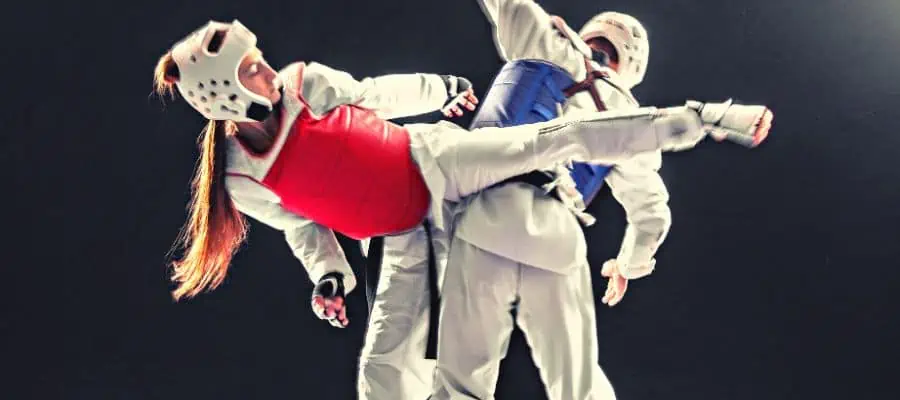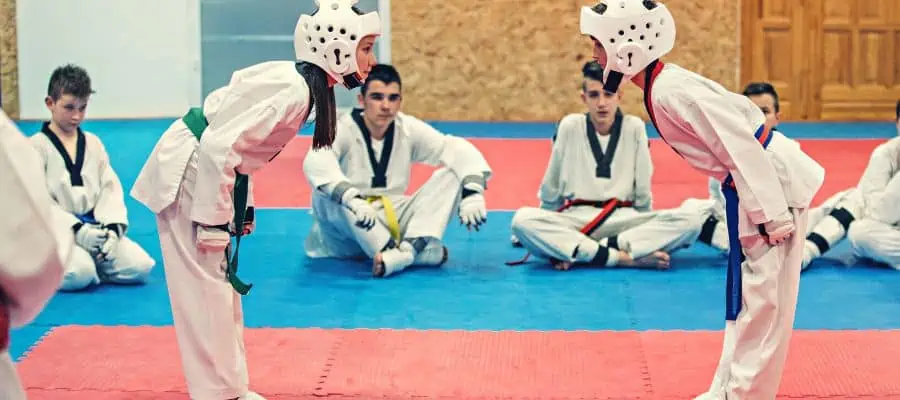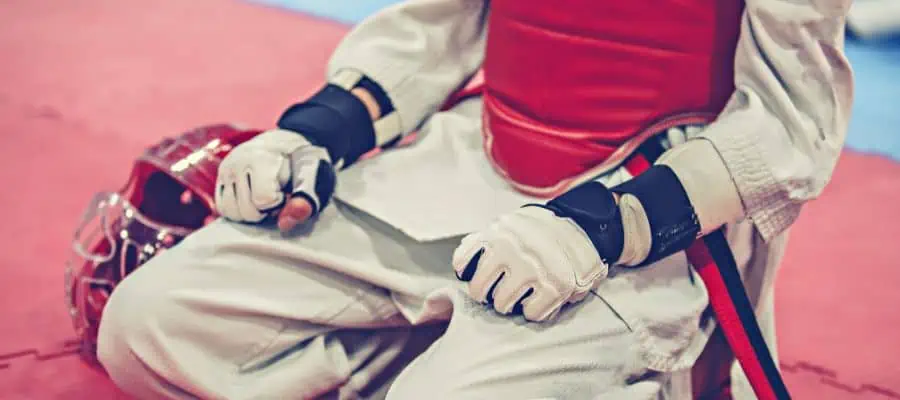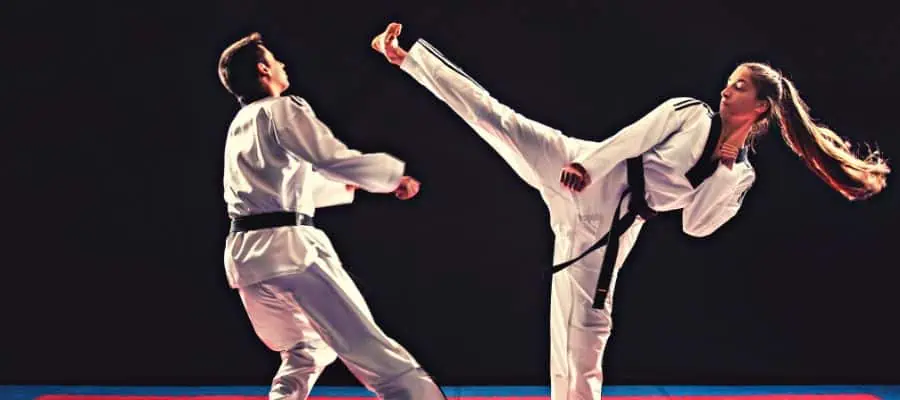Taekwondo focuses on kicks, making it essential for practitioners to develop robust and precise kicks. While learning the proper technique is crucial, improving kicking power is equally important to excel in the sport. There are various ways to increase kicking power in Taekwondo.
Proper Technique And Form

Warm Up Properly
This is the first step to improving your kicks in Taekwondo. This helps prevent injuries and prepares your muscles for physical activity. A proper warm-up should include stretching exercises such as hamstring, quad, and hip stretches.
Stance
Once you are warmed up, focus on your stance. A proper stance is crucial for good kicks. Keep your feet shoulder-width apart, with the knees slightly bent. Your body weight should be evenly distributed on both feet. Your body should be bladed at an angle with your hands up.
Practice The Basics
Kicks such as basic front kick, side kick, roundhouse kick, and back kick. Mastering the basics will help you develop good technique and form. Pay attention to the mechanics of each kick, including the position of your hips, shoulders, and foot. Ensure you use the correct muscles and engage your core for maximum power.
Drills
This method can help you improve your kicks. Kicking a target repeatedly can help you develop speed and accuracy. Additionally, practicing footwork drills can help you move more efficiently and effectively.
Feedback
It’s important to seek feedback from a qualified instructor or experienced practitioner. They can highlight areas for improvement and provide guidance on proper technique and form. They can also offer additional training drills and exercises to help you improve your kicks.
Strengthening Exercises For Legs

Taekwondo is a martial art that places a lot of emphasis on leg strength, as powerful kicks are a key aspect of the practice.
Squats
Squats work the quadriceps, hamstrings, and glutes, which are all essential muscles for powerful kicks. A squat involves standing with your feet shoulder-width apart and lowering your body as if sitting in a chair. Keep your back straight, and make sure your knees do not extend past your toes. As you progress, you can add weights to increase the resistance and make the exercise more challenging.
Lunges
This is an excellent exercise for strengthening your legs. Lunges target the same muscles as squats but emphasize the glutes and hamstrings more. Step forward with one foot to perform a lunge, bending your knee until your thigh is parallel to the ground. Keep your back straight, and push back up to the starting position. As you progress, you can add weights to increase the resistance and make the exercise more difficult.
Calf Raises
Another excellent exercise for building leg strength for Taekwondo. Calf raises target the muscles in your calves, which are crucial for fast footwork. Stand on a step or ledge with your feet on the edge, and lower your heels as far as possible. Push onto the toes, and hold for a second before lowering back down. You can also add weights to increase the resistance and make the exercise more challenging.
Plyometric Exercises

Plyometric exercises are a powerful tool for improving your kicks in Taekwondo. Incorporating explosive movements into your training routine can build strength and power. Which enables you to execute fast and dynamic kicks.
Start Slowly
If you’re new to plyometric exercises, starting slowly is essential. Once you understand the exercises’ mechanics, you can increase your workouts’ intensity. Begin with low-impact exercises like jump squats or box jumps. Then progressively work your way up to more advanced practices like depth jumps or single-leg jumps.
Focus On Form
Proper form is essential when performing plyometric exercises. Ensure you maintain good posture, align your knees with your toes, and land softly and with control. If unsure about your form, consider working with a qualified trainer or instructor.
Incorporate Variety
To get the most out of plyometric exercises, it’s essential to incorporate a variety of movements. Try different exercises that target other muscle groups. Jumping lunges for your quads and glutes or skater jumps for your lateral movement and balance.
Equipment
Plyometric exercises can be performed with little to no equipment. Though equipment like resistance bands or plyometric boxes can help add variety and intensity to your workouts. Experiment with different types of equipment to find what works best for you.
Resistance Training

Resistance training can effectively improve your kicking strength, power, and speed in Taekwondo.
Resistance Bands
Resistance bands can be a great way to train your leg muscles for explosive power. You can perform various kicking drills with resistance bands around your legs or ankles. For example, you can attach the bands to a fixed point and practice kicking with resistance. You can wrap the bands around your legs while performing squat jumps or lunges.
Weighted Ankle Weights
Ankle weights can be used to increase resistance and add weight to your kicks. It is essential to start with lighter weights and gradually increase the weight as your strength improves.
Resistance Machines
Resistance machines include leg presses, calf raises, and hamstring curl machines. These can all be used to target specific leg muscles and build strength in those muscles.
Resistance Training With A Partner
Training this way is an effective way to improve your kicking power. Your partner can hold pads or shields, and you can practice kicking against them with maximum force.
Core Strengthening Exercises

Core strengthening exercises can be an effective way to improve your kicks in Taekwondo. A strong core provides stability and power to your kicks, helping you to generate more force and speed.
Planks
Planks are a great core strengthening exercise that targets your abs, lower back, and hip muscles. To perform a plank, get into a push-up position. The arms and body should be straight from your head to your heels. Hold this position for as long as possible, keeping your core muscles engaged.
Russian Twists
Russian twists are another excellent exercise that targets your oblique muscles. To perform a Russian twist, sit on the floor knees should be bent. Lean back; your heels should be off the ground. Hold a kettlebell or medicine ball in your hands and twist your torso to one side, then the other.
Bicycle Crunches
Bicycle crunches target your abs and obliques. To perform a bicycle crunch, lie on your back with your hands on the floor and your knees bent. Lift your shoulders off the ground, bring your left elbow towards your right knee, and switch sides.
Leg Raises
Leg raises are an effective exercise that targets your lower abs. To perform a leg raise, lie on your back with your legs straight. Lift your legs off the ground and raise them towards the ceiling. Lower your leg down to the ground and repeat on each leg.
Flexibility And Stretching

Flexibility and stretching are critical components of Taekwondo training. This is especially true when it comes to improving your kicks.
Dynamic Stretching
Dynamic stretching involves moving your body through a range of motion to warm up. Dynamic stretching exercises such as leg swings, high knees, and lunges can help improve your range of motion in your kicks.
Static Stretching
This type of stretching involves holding a stretch for an extended period, usually 15 to 30 seconds. Static stretching exercises such as hamstring, calf, and hip flexor stretches. These can help improve your flexibility and range of motion for your kicks.
PNF Stretching
Proprioceptive Neuromuscular Facilitation stretching is an advanced stretching technique. This can help improve flexibility and range of motion. PNF stretching involves contracting and relaxing your muscles while holding a stretch.
For example, you can stretch a hamstring by lifting your leg and holding it while pushing against a partner’s resistance. Then, relax and stretch your hamstrings further. This method can be applied to numerous types of stretches
Yoga
Practicing yoga can help improve your flexibility, balance, and strength. Yoga poses such as the downward dog, warrior pose, and triangle pose can help to stretch and strengthen your leg muscles.
Speed And Agility Drills

Improving your speed and agility can significantly impact your ability to perform kicks in Taekwondo.
Jumping Exercises
Jumping exercises such as jump squats, box jumps, and hurdle jumps. They can help to improve your explosive power, speed, and agility. These exercises work your leg muscles and help you to generate more force and speed when performing kicks.
Ladder Drills
Agility ladder drills can help to improve your footwork, coordination, and speed. Ladder drills involve stepping, hopping, or jumping through an agility ladder. These drills can be done forwards, backward, sideways, or diagonally. They can be customized to focus on specific movements used in Taekwondo.
Cone Drills
Cone drills involve setting up a series of cones in a specific pattern and running through them as quickly as possible. These drills help to improve your speed, agility, and change of direction. This can be beneficial for performing kicks in Taekwondo.
Reaction Drills
Reaction drills involve reacting quickly to a visual or auditory stimulus. For example, you can set up a target and have a partner call out a specific kick to perform. Where by forcing you to react quickly to enhance your timing.
Shadow Sparring
Training involves a series of kicks and strikes in a predetermined pattern without a partner. This drill helps to improve your speed, accuracy, and muscle memory, which can be beneficial for performing kicks in Taekwondo.
Proper Nutrition And Hydration

Proper nutrition and hydration are essential to any athletic training program, including Taekwondo.
Stay Hydrated
Hydration is essential for athletic performance, including in Taekwondo. One should drink at least eight cups of water daily, and more if you are training or competing intensely. Drinking water helps to keep your muscles hydrated and working efficiently, reducing the risk of cramping and fatigue.
Eat A Balanced Diet
A balanced diet can help to fuel your body for optimal performance. Focus on whole, nutrient-dense foods that provide sustained energy throughout the day.
Eat Before And After Training
Eating a meal or snack before and after training can help to fuel your body and aid in muscle recovery. Aim to eat a meal or snack containing protein, carbohydrates, and healthy fats. Before and after training, this can provide sustained energy and help repair muscle tissue.
Supplement Wisely
If you have difficulty meeting your nutritional needs through your diet. Supplements such as protein powder or multivitamins can be added to your routine to optimize performance.
Rest And Recovery

Rest and recovery are crucial components of any training program, including Taekwondo.
Get Enough Sleep
Sleep is vital for muscle recovery and growth, which are essential for improving your kicks in Taekwondo. One should get at least seven to eight hours of sleep each night to give your body the time it needs to repair and rejuvenate.
Take Rest Days
Rest days are essential to allow your body time to recover from intense training sessions. Aim to take at least one or two days off from training each week to allow your body to rest and recover.
Listen To Your Body
It’s essential to listen to your body When it needs rest. If you’re feeling fatigued or experiencing muscle soreness or pain, take a break from training to allow your body time to recover.
Mental Training And Visualization Techniques

Mental training and visualization techniques can be powerful tools for improving your kicks.
Set Goals
Setting specific, measurable, and achievable goals can help you focus your mental training efforts. Identify goals for your kicks in Taekwondo and create a plan to get there.
Visualize Success
This technique involves imagining yourself performing a skill or activity successfully. Close your eyes and visualize yourself executing a perfect kick. Imagine the feeling of your foot connecting with your target and the sound of your breath as you exhale with each kick.
Manage Performance Anxiety
Performance anxiety can negatively impact your kicks in Taekwondo. Use mental training to manage performance anxiety by practicing relaxation techniques like deep breathing or progressive muscle relaxation. Reframe negative thoughts into positive self-talk, reminding yourself of your capabilities and achievements.
Conclusion
Improving kicking power in Taekwondo requires a combination of methods. By incorporating these tips, practitioners can enhance their kicks and achieve their sports goals. Remember to always consult with a coach or trainer and tailor the training to your level and abilities to avoid injury and maximize results. You can take your kicking power to the next level with consistent practice and dedication.
Recent Posts
Taekwondo, a Korean martial art, is widely known for its fast and dynamic kicks. It has gained significant popularity worldwide due to its effectiveness in combat sports like the UFC. Over the years,...
When it comes to martial arts, there are many different styles from which you can choose. But what are the differences between these four styles? Muay Thai, Kickboxing, Taekwondo, and Karate are...
